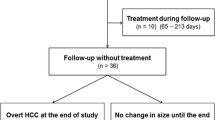Abstract
Objectives
To compare treatment outcomes of subcentimeter hypervascular nodules at high risk for developing into hepatocellular carcinomas (SHNHR) between early treatment and watchful waiting until progression to overt hepatocellular carcinoma (HCC) groups.
Methods
SHNHRs were defined as subcentimeter hypervascular nodules with the usual imaging features of HCC on gadoxetic acid-enhanced magnetic resonance imaging (MRI). Among 63 patients with 74 SHNHRs, 27 (37 SHNHRs) received early treatment (treatment of < 1 cm nodules), and 36 (37 SHNHRs) underwent watchful waiting until progression to overt HCC. Risk factor analysis was performed for recurrence-free and local recurrence-free survival.
Results
Among the 36 patients who adopted watchful waiting, 33 eventually underwent treatment because their SHNHRs progressed to overt HCC. For recurrence-free survival, significant risk factors included number of previous treatments (HR, 1.181; p < 0.001), tumour number (HR, 1.943; p = 0.009), and α-feto protein level (HR, 1.005; p = 0.037) in the multivariate analyses. Treatment strategy was not a significant risk factor for recurrence-free survival. For local recurrence-free survival from the date of treatment, only treatment modality (transarterial chemoembolization) (HR, 6.879; p = 0.002) was a significant risk factor.
Conclusion
Recurrence-free survival was not significantly different between early treatment and watchful waiting for SHNHRs.
Key Points
• Recurrence-free survival did not vary between the two treatment strategies.
• Treatment modality was a significant factor for local recurrence-free survival.
• Number of treatments, tumour number, and α-FP were risk factors for recurrence.





Similar content being viewed by others
Abbreviations
- HCC:
-
hepatocellular carcinoma
- MRI:
-
magnetic resonance imaging
- DWI:
-
diffusion weighted imaging
- SHNHR:
-
subcentimeter hypervascular nodules at high risk for developing into HCC
- T2WI:
-
T2 weighted imaging
- TACE:
-
transarterial chemoembolization
- RF:
-
radiofrequency
- ALT:
-
alanine aminotransferase
- HR:
-
hazard ratio
- CI:
-
confidence interval
References
Parkin DM, Bray F, Ferlay J, Pisani P (2001) Estimating the world cancer burden: Globocan 2000. Int J Cancer 94:153–156
Yuen MF, Cheng CC, Lauder I, Lam SK, Ooi CG, Lai CL (2000) Early detection of hepatocellular carcinoma increases the chance of treatment: Hong Kong experience. Hepatology 31:330–335
Bruix J, Llovet JM (2009) Major achievements in hepatocellular carcinoma. Lancet 373:614–616
Kim SH, Kim SH, Lee J et al (2009) Gadoxetic acid–enhanced MRI versus triple-phase MDCT for the preoperative detection of hepatocellular carcinoma. Am J Roentgenol 192:1675–1681
Kim J-E, Kim SH, Lee SJ, Rhim H (2011) Hypervascular hepatocellular carcinoma 1 cm or smaller in patients with chronic liver disease: characterization with gadoxetic acid–enhanced MRI that includes diffusion-weighted imaging. Am J Roentgenol 196:W758–W765
Park MJ, Kim YK, Lee MW et al (2012) Small hepatocellular carcinomas: improved sensitivity by combining gadoxetic acid–enhanced and diffusion-weighted MR imaging patterns. Radiology 264:761–770
Merkle EM, Zech CJ, Bartolozzi C et al (2016) Consensus report from the 7th international forum for liver magnetic resonance imaging. Eur Radiol 26:674–682
Neri E, Bali MA, Ba-Ssalamah A et al (2016) ESGAR consensus statement on liver MR imaging and clinical use of liver-specific contrast agents. Eur Radiol 26:921–931
Bruix J, Sherman M (2011) Management of hepatocellular carcinoma: an update. Hepatology 53:1020–1022
Song KD, Kim SH, Lim HK, Jung SH, Sohn I, Kim HS (2015) Subcentimeter hypervascular nodule with typical imaging findings of hepatocellular carcinoma in patients with history of hepatocellular carcinoma: natural course on serial gadoxetic acid-enhanced MRI and diffusion-weighted imaging. Eur Radiol 25:2789–2796
Nasu K, Kuroki Y, Tsukamoto T, Nakajima H, Mori K, Minami M (2009) Diffusion-weighted imaging of surgically resected hepatocellular carcinoma: imaging characteristics and relationship among signal intensity, apparent diffusion coefficient, and histopathologic grade. Am J Roentgenol 193:438–444
Willatt JM, Hussain HK, Adusumilli S, Marrero JA (2008) MR Imaging of hepatocellular carcinoma in the cirrhotic liver: challenges and controversies. Radiology 247:311–330
Lee EW, Wei L, Amato DA (1992) Cox-type regression analysis for large number of small groups of correlated failure time observations. In: Klein JP, Goel PK (eds) Survival analysis, State of the art. Kluwer Academic Publishers, Dordrecht, pp 237–247
Shah SA, Cleary SP, Wei AC et al (2007) Recurrence after liver resection for hepatocellular carcinoma: risk factors, treatment, and outcomes. Surgery 141:330–339
Belghiti J, Panis Y, Farges O, Benhamou JP, Fekete F (1991) Intrahepatic recurrence after resection of hepatocellular carcinoma complicating cirrhosis. Ann Surg 214:114–117
Shiina S, Tateishi R, Arano T et al (2012) Radiofrequency ablation for hepatocellular carcinoma: 10-year outcome and prognostic factors. Am J Gastroenterol 107:569–577, quiz 578
Kim YS, Lim HK, Rhim H et al (2013) Ten-year outcomes of percutaneous radiofrequency ablation as first-line therapy of early hepatocellular carcinoma: analysis of prognostic factors. J Hepatol 58:89–97
Pawlik TM, Delman KA, Vauthey JN et al (2005) Tumor size predicts vascular invasion and histologic grade: implications for selection of surgical treatment for hepatocellular carcinoma. Liver Transpl 11:1086–1092
Kudo M, Izumi N, Kokudo N et al (2011) Management of hepatocellular carcinoma in Japan: consensus-based clinical practice guidelines proposed by the Japan Society of Hepatology (JSH) 2010 updated version. Dig Dis 29:339–364
Wu JC, Huang YH, Chau GY et al (2009) Risk factors for early and late recurrence in hepatitis B-related hepatocellular carcinoma. J Hepatol 51:890–897
Kim JW, Kim JH, Sung KB et al (2014) Transarterial chemoembolization vs. radiofrequency ablation for the treatment of single hepatocellular carcinoma 2 cm or smaller. Am J Gastroenterol 109:1234–1240
Peng SY, Chen WJ, Lai PL, Jeng YM, Sheu JC, Hsu HC (2004) High alpha-fetoprotein level correlates with high stage, early recurrence and poor prognosis of hepatocellular carcinoma: significance of hepatitis virus infection, age, p53 and beta-catenin mutations. Int J Cancer 112:44–50
Author information
Authors and Affiliations
Corresponding author
Rights and permissions
About this article
Cite this article
Woo, J.H., Song, K.D. & Kim, S.H. Subcentimeter hypervascular nodules with typical imaging findings of hepatocellular carcinoma on gadoxetic acid-enhanced MRI: Outcomes of early treatment and watchful waiting. Eur Radiol 27, 4406–4414 (2017). https://doi.org/10.1007/s00330-017-4818-8
Received:
Revised:
Accepted:
Published:
Issue Date:
DOI: https://doi.org/10.1007/s00330-017-4818-8




